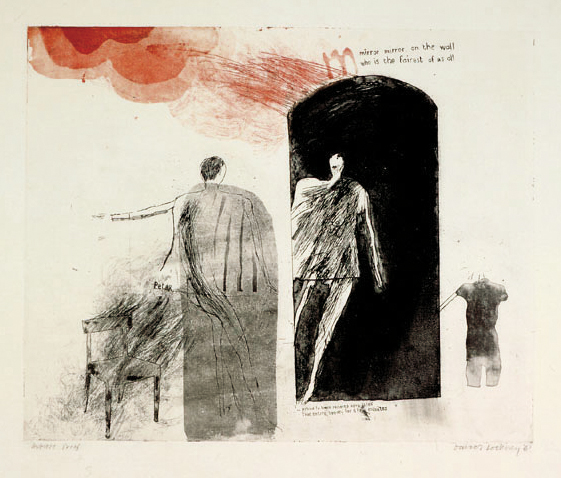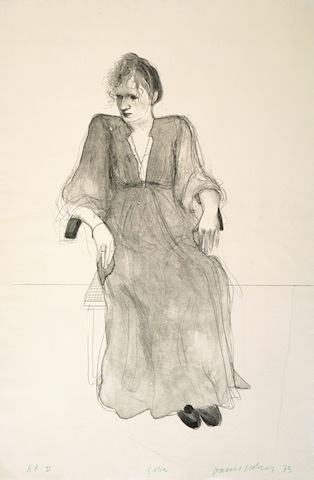Hockney: Printmaker, Dulwich Picture Gallery | reviews, news & interviews
Hockney: Printmaker, Dulwich Picture Gallery
Hockney: Printmaker, Dulwich Picture Gallery
A joyous exhibition celebrating David Hockney's long and fruitful career as a printmaker

David Hockney has been a printmaker for almost as long as he’s been a painter.
Being a penurious student at the Royal College of Art in 1959, and finding that he had to pay for his own painting materials, Hockney was drawn to the print department which supplied equipment and materials to students for free. And so began his adventures in print, which have seen him experiment in a wide variety of print media.
In Hockney’s hands A Rake’s Progress becomes a tale of self-actualisation
This exhibition celebrates his work as a printmaker across those decades, from that highly accomplished self-portrait of 1954, to the very early etchings of the Sixties, and then on to his experiments with colour photocopy-printing in the Eighties and finally computer-drawing, a laborious and impractical method when Hockney started in the early Nineties, but now made quicker – as quick as applying a pencil to paper – with the advent of the iPhone and the iPad. (However, none of the iPad drawings, which were shown to such dazzling effect at his 2012 Royal Academy exhibition, A Bigger Picture, are shown here – perhaps because they’re much closer to the spontaneity of drawing than traditional printmaking).
It was Hockney’s early etchings while still a student at the RCA that helped make his name, through works such as Kaisarion with all His Beauty, and Mirror, Mirror on the Wall (pictured below), both allusions to poems by Alexandrian poet C.P Cavafy, who also influenced a later series by Hockney depicting naked gay lovers while male homosexuality was still illegal in Britain. While the later Cavafy prints are largely naturalistic, the two earlier works, both dated 1961, possess all the delicacy of line and imaginative playfulness of Klee, coupled with the figurative imagery reminiscent of Art Brut artist Jean Dubuffet. Hockney’s use of text also suggests graffiti.
 These works in themselves don’t appear particularly narrative-driven, though Hockney is an artist inspired by words and stories. Print-making, he’s said, gave him the opportunity to work serially, in a way he felt he couldn’t as a painter. We find etchings inspired by both Picasso's The Blue Guitarist and Wallace Stevens' great poem The Blue Guitar, in turn inspired by Picasso's painting. A fine portrait of the poet appears surrounded by various motifs including a guitar. His 16-series etching, A Rake’s Progress, 1961-63, is a modern retelling of Hogarth’s eponymous set of eight prints relating the story of a young man’s moral corruption and descent into despair and madness. Hockney naturally dispenses with the tale’s moral purpose and humorously reframes it as a young man’s adventures in New York, giving himself the title role.
These works in themselves don’t appear particularly narrative-driven, though Hockney is an artist inspired by words and stories. Print-making, he’s said, gave him the opportunity to work serially, in a way he felt he couldn’t as a painter. We find etchings inspired by both Picasso's The Blue Guitarist and Wallace Stevens' great poem The Blue Guitar, in turn inspired by Picasso's painting. A fine portrait of the poet appears surrounded by various motifs including a guitar. His 16-series etching, A Rake’s Progress, 1961-63, is a modern retelling of Hogarth’s eponymous set of eight prints relating the story of a young man’s moral corruption and descent into despair and madness. Hockney naturally dispenses with the tale’s moral purpose and humorously reframes it as a young man’s adventures in New York, giving himself the title role.
As he makes his way through a sequence of encounters, the series finds him firmly establishing himself as an artist (with the sale of a print to MoMA), taking in a bit of sight-seeing, going to a gay bar and observing the back view of an identikit row of cool young men in clingy T-shirts, all listening to radio transistor headphones, which were not yet available in Old Blighty. In Hockney’s hands A Rake’s Progress becomes a tale of self-actualisation.
 Particularly impressive are the soft, velvety lithographs, a medium Hockney returned to many years after his first foray, of the mid-Seventies, portraying friends and lovers. Peter Schlesinger, former lover and muse, looks at us with a solemn, liquid gaze in an arresting bust portrait, while fashion designer Celia Birtwell (pictured right) sits in a chair with her head half turned, beautiful and pensive, the sweeping lines of her dress lending the image heightened, yet delicate, sensuality. Henry at the Table (main picture) shows the American art historian and curator Henry Geldzahler sitting in profile at a table, his fat hands clasped in front of him in line with the lone, fragile-looking pot plant opposite, whose symbolism seems apparent. Hockney is great at capturing mood and expression in a face, even when we can't see much of it.
Particularly impressive are the soft, velvety lithographs, a medium Hockney returned to many years after his first foray, of the mid-Seventies, portraying friends and lovers. Peter Schlesinger, former lover and muse, looks at us with a solemn, liquid gaze in an arresting bust portrait, while fashion designer Celia Birtwell (pictured right) sits in a chair with her head half turned, beautiful and pensive, the sweeping lines of her dress lending the image heightened, yet delicate, sensuality. Henry at the Table (main picture) shows the American art historian and curator Henry Geldzahler sitting in profile at a table, his fat hands clasped in front of him in line with the lone, fragile-looking pot plant opposite, whose symbolism seems apparent. Hockney is great at capturing mood and expression in a face, even when we can't see much of it.
As we progress through the decades, colours become bolder, richer, hotter. They sing out, but sometimes shriek. A series of lithographs of a hotel garden in Mexico captures the intense heat, though a few make you wince with their harsh, garish notes. I’m not so keen on the faceted multi-view images of the Eighties, which seem to me to be superficial reruns of Cubism and feel like pictorial dead-ends. But this seems an interest that continues to fascinate Hockney, if no longer on canvas and paper than on film, as we saw in his otherwise superb Royal Academy exhibition. But other than that, this is a joyous exhibition of Hockney's brilliant adventures in print.
Explore topics
Share this article
The future of Arts Journalism
You can stop theartsdesk.com closing!
We urgently need financing to survive. Our fundraising drive has thus far raised £49,000 but we need to reach £100,000 or we will be forced to close. Please contribute here: https://gofund.me/c3f6033d
And if you can forward this information to anyone who might assist, we’d be grateful.

Subscribe to theartsdesk.com
Thank you for continuing to read our work on theartsdesk.com. For unlimited access to every article in its entirety, including our archive of more than 15,000 pieces, we're asking for £5 per month or £40 per year. We feel it's a very good deal, and hope you do too.
To take a subscription now simply click here.
And if you're looking for that extra gift for a friend or family member, why not treat them to a theartsdesk.com gift subscription?
more Visual arts
 'We are bowled over!' Thank you for your messages of love and support
Much-appreciated words of commendation from readers and the cultural community
'We are bowled over!' Thank you for your messages of love and support
Much-appreciated words of commendation from readers and the cultural community
 Lee Miller, Tate Britain review - an extraordinary career that remains an enigma
Fashion photographer, artist or war reporter; will the real Lee Miller please step forward?
Lee Miller, Tate Britain review - an extraordinary career that remains an enigma
Fashion photographer, artist or war reporter; will the real Lee Miller please step forward?
 Kerry James Marshall: The Histories, Royal Academy review - a triumphant celebration of blackness
Room after room of glorious paintings
Kerry James Marshall: The Histories, Royal Academy review - a triumphant celebration of blackness
Room after room of glorious paintings
 Folkestone Triennial 2025 - landscape, seascape, art lovers' escape
Locally rooted festival brings home many but not all global concerns
Folkestone Triennial 2025 - landscape, seascape, art lovers' escape
Locally rooted festival brings home many but not all global concerns
 Sir Brian Clarke (1953-2025) - a personal tribute
Remembering an artist with a gift for the transcendent
Sir Brian Clarke (1953-2025) - a personal tribute
Remembering an artist with a gift for the transcendent
 Emily Kam Kngwarray, Tate Modern review - glimpses of another world
Pictures that are an affirmation of belonging
Emily Kam Kngwarray, Tate Modern review - glimpses of another world
Pictures that are an affirmation of belonging
 Kiefer / Van Gogh, Royal Academy review - a pairing of opposites
Small scale intensity meets large scale melodrama
Kiefer / Van Gogh, Royal Academy review - a pairing of opposites
Small scale intensity meets large scale melodrama
 Jenny Saville: The Anatomy of Painting, National Portrait Gallery review - a protégé losing her way
A brilliant painter in search of a worthwhile subject
Jenny Saville: The Anatomy of Painting, National Portrait Gallery review - a protégé losing her way
A brilliant painter in search of a worthwhile subject
 Abstract Erotic, Courtauld Gallery review - sculpture that is sensuous, funny and subversive
Testing the boundaries of good taste, and winning
Abstract Erotic, Courtauld Gallery review - sculpture that is sensuous, funny and subversive
Testing the boundaries of good taste, and winning
 Edward Burra, Tate Britain review - watercolour made mainstream
Social satire with a nasty bite
Edward Burra, Tate Britain review - watercolour made mainstream
Social satire with a nasty bite
 Ithell Colquhoun, Tate Britain review - revelations of a weird and wonderful world
Emanations from the unconscious
Ithell Colquhoun, Tate Britain review - revelations of a weird and wonderful world
Emanations from the unconscious
 Rachel Jones: Gated Canyons, Dulwich Picture Gallery review - teeth with a real bite
Mouths have never looked so good
Rachel Jones: Gated Canyons, Dulwich Picture Gallery review - teeth with a real bite
Mouths have never looked so good

Add comment